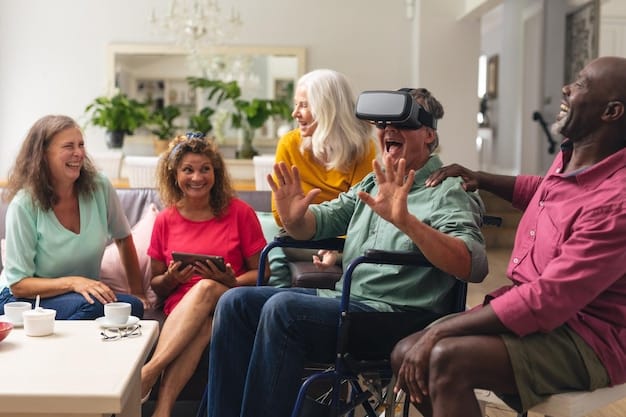The Future of Caregiving: Trends & Innovations in 2025

The future of caregiving in 2025 will be shaped by technological advancements, innovative care models, and increased focus on caregiver support, offering more personalized and efficient solutions.
The landscape of caregiving is rapidly evolving, and understanding the trends and innovations on the horizon is crucial. This article explores the future of caregiving: trends and innovations to watch in 2025, providing valuable insights for caregivers, families, and healthcare professionals.
The Rise of Technology in Caregiving
Technology is poised to revolutionize caregiving, offering solutions to address the growing demands and challenges. Integration of smart devices, AI-powered tools, and telehealth services promises to enhance the quality of care and improve the lives of both caregivers and care recipients.
Smart Home Integration
Smart home devices are becoming increasingly common in caregiving settings, enabling remote monitoring and assistance. These devices can track vital signs, detect falls, and even provide medication reminders, ensuring the safety and well-being of care recipients.
The adoption of smart home technology not only enhances safety but also promotes independence. Care recipients can maintain a greater sense of control over their environment, while caregivers gain peace of mind knowing they can monitor their loved ones remotely.
AI-Powered Assistance
Artificial intelligence (AI) is emerging as a powerful tool in caregiving, offering personalized support and predictive analytics. AI-powered virtual assistants can provide companionship, answer questions, and even offer emotional support to care recipients.
Beyond companionship, AI can analyze data to predict potential health issues and alert caregivers to take proactive measures. This predictive capability can significantly improve health outcomes and reduce the burden on the healthcare system.
- AI-driven medication management systems
- Smart sensors for fall detection and prevention
- Personalized virtual health assistants

In conclusion, technology plays a vital role in shaping the future, integrating smart home solutions and AI to enhance the safety and health for both caregivers and care recipients, and leading towards better quality of life.
Telehealth Expansion and Remote Monitoring
Telehealth is expanding rapidly, offering convenient and accessible healthcare services for care recipients. This trend allows for remote consultations, monitoring, and support, reducing the need for frequent in-person visits and improving access to care.
Benefits of Telehealth
Telehealth offers numerous benefits, including increased convenience, reduced healthcare costs, and improved access to specialists. Care recipients can receive timely medical advice and support from the comfort of their homes, minimizing disruptions to their daily routines.
For caregivers, telehealth can alleviate the burden of transportation and waiting times, allowing them to focus on providing direct care and support. Remote monitoring also enables caregivers to stay informed about their loved ones’ health status and address any concerns promptly.
Remote Monitoring Devices
Remote monitoring devices are becoming increasingly sophisticated, allowing for continuous tracking of vital signs and health indicators. These devices can transmit data to healthcare providers in real-time, enabling early detection of potential health issues and timely intervention.
The use of remote monitoring devices can improve health outcomes, reduce hospital readmissions, and enhance the overall quality of care. Caregivers can also benefit from the data collected, using it to make informed decisions about their loved ones’ care plans.
- Wearable sensors for continuous vital sign monitoring
- Home-based diagnostic devices for remote testing
- Video consultation platforms for virtual doctor visits
Telehealth and monitoring devices enable efficient and quick healthcare services, ensuring both caregivers and care recipients can benefit in the comfort of their homes.
Personalized Care Plans and Individualized Support
Personalized care plans are gaining prominence, recognizing the unique needs and preferences of each care recipient. These plans are tailored to individual circumstances, taking into account factors such as medical history, lifestyle, and cultural background.
Tailoring Care to Individual Needs
Personalized care plans involve a comprehensive assessment of the care recipient’s needs, including physical, emotional, and social well-being. This assessment informs the development of a customized care plan that addresses specific challenges and goals.
Caregivers play a crucial role in the development and implementation of personalized care plans, providing valuable insights into their loved ones’ daily routines and preferences. Collaboration between caregivers, healthcare professionals, and care recipients ensures that the care plan is effective and sustainable.
Emphasis on Emotional and Mental Well-being
In addition to physical care, personalized care plans emphasize the importance of emotional and mental well-being. Care recipients are encouraged to engage in activities that promote social interaction, cognitive stimulation, and emotional support.
Caregivers are also encouraged to prioritize their own emotional and mental health, recognizing that their well-being is essential to providing high-quality care. Support groups, counseling services, and respite care can help caregivers manage stress and prevent burnout.

- Customized activity programs to promote engagement and well-being
- Access to mental health professionals for counseling and support
- Integration of alternative therapies such as art and music therapy
Personalized health plans offer tailored solutions which ensure mental and emotional well-being, as well as collaboration between caregivers and care recipients to create the best possible plan.
The Growing Demand for Skilled Caregivers
The demand for skilled caregivers is increasing, driven by the aging population and the growing prevalence of chronic diseases. This trend highlights the need for comprehensive training and support programs to prepare caregivers for the challenges of their role.
Professional Training and Certification
Professional training and certification programs are becoming increasingly important for caregivers, providing them with the knowledge and skills needed to deliver high-quality care. These programs cover topics such as basic healthcare, medication management, and communication skills.
Certification demonstrates a caregiver’s competence and commitment to providing excellent care, enhancing their credibility and increasing their employment opportunities. Employers are increasingly seeking certified caregivers to ensure the safety and well-being of their clients.
Focus on Specialized Care
As the population ages, there is a growing need for caregivers with specialized skills in areas such as dementia care, palliative care, and geriatric care. These specialized caregivers can provide tailored support to individuals with specific health conditions and needs.
Caregivers with specialized skills are in high demand, and they often command higher wages than those without specialized training. Continuous professional development and advanced certifications can help caregivers stay at the forefront of their field and provide the best possible care.
Caregivers must be skilled and up-to-date on their knowledge, requiring professional training in areas such as medication management and basic healthcare, ensuring quality care for care recipients.
Innovative Eldercare Models and Community Support
Innovative eldercare models are emerging, offering alternatives to traditional nursing homes and assisted living facilities. These models emphasize community-based care, social engagement, and independence, promoting a higher quality of life for older adults.
Aging in Place Initiatives
Aging in place initiatives are designed to support older adults in maintaining their independence and staying in their homes for as long as possible. These initiatives often involve home modifications, assistive technology, and access to community-based services.
Aging in place can improve quality of life, reduce healthcare costs, and enhance social connections for older adults. Caregivers play a vital role in supporting aging in place, providing assistance with daily tasks and ensuring the safety and well-being of their loved ones.
Intergenerational Programs
Intergenerational programs are gaining popularity, bringing together older adults and younger generations for mutually beneficial activities. These programs can promote social interaction, reduce loneliness, and foster a sense of purpose for both age groups.
Intergenerational programs can take many forms, including shared housing, mentoring programs, and volunteer opportunities. These programs can create meaningful connections and break down age-related stereotypes, benefiting individuals and communities alike.
- Community centers offering a variety of activities and services
- Volunteer programs connecting older adults with younger volunteers
- Shared housing arrangements that promote intergenerational living
Eldercare models offer independence and social engagement via intergenerational programs and community services, improving the quality of life for the aging.
Addressing Caregiver Burnout and Promoting Well-being
Caregiver burnout is a significant concern, affecting the physical, emotional, and financial well-being of caregivers. It is crucial to address this issue by promoting self-care, providing access to support services, and advocating for policies that support caregivers.
Respite Care and Support Services
Respite care offers temporary relief for caregivers, allowing them to take a break and recharge. Respite care can be provided in the home, in a community center, or in a residential facility, depending on the needs of the caregiver and care recipient.
Support groups, counseling services, and online communities can provide caregivers with emotional support and practical advice. Connecting with others who understand the challenges of caregiving can reduce feelings of isolation and improve overall well-being.
Advocacy and Policy Changes
Advocacy and policy changes are needed to recognize the value of caregiving and provide caregivers with the support they need. This includes policies such as paid family leave, tax credits for caregiving expenses, and expanded access to respite care.
By advocating for caregiver-friendly policies, we can create a society that values and supports caregivers, ensuring that they have the resources and recognition they deserve. This will not only improve the lives of caregivers but also enhance the quality of care for all individuals in need.
Addressing burnout and supporting caregivers is essential for ensuring a sustainable and compassionate care system, with help from family leave and policies.
Financial Innovations in Caregiving
Financial innovations are emerging to help families better manage the costs associated with caregiving. These include long-term care insurance, government assistance programs, and innovative financing models that provide financial relief and support.
Long-Term Care Insurance
Long-term care insurance can help cover the costs of care for individuals who require assistance with daily activities. This insurance can provide financial protection against the high costs of long-term care, allowing families to maintain their financial stability.
While long-term care insurance can be a valuable asset, it is important to understand the terms and conditions of the policy before purchasing it. Factors such as age, health status, and the level of coverage needed should be considered when making a decision.
Government Assistance Programs
Government assistance programs such as Medicaid and Medicare can provide financial support for eligible individuals who require long-term care. These programs offer a range of services, including home healthcare, nursing home care, and respite care.
Eligibility requirements for government assistance programs vary depending on the program and the state. It is important to understand the eligibility criteria and application process to access these valuable resources.
- Crowdfunding platforms for raising money for caregiving expenses
- Reverse mortgages to unlock home equity for care costs
- Tax credits and deductions for caregiving expenses
Providing financial relief for assistance, government programs, and insurance helps families support caregiving costs and increase their financial stability.
| Key Point | Brief Description |
|---|---|
| 🤖 AI in Caregiving | AI offers personalized support, companionship, and predictive health analytics. |
| 📱 Telehealth Expansion | Telehealth provides convenient access to healthcare services remotely, reducing the need for in-person visits. |
| 🏡 Aging in Place | Initiatives support older adults in maintaining independence and staying in their homes. |
| ❤️🩹 Caregiver Support | Addressing burnout through respite care, support groups, and advocating for policies. |
Frequently Asked Questions
▼
Key trends include smart home integration, AI-powered assistance, and telehealth services, which offer remote monitoring and personalized support.
▼
Telehealth increases convenience, reduces healthcare costs, improves access to specialists, and enables remote monitoring for timely intervention.
▼
Personalized care plans prioritize individual needs, including emotional and mental well-being, promoting tailored support and engagement.
▼
Caregivers can prevent burnout by accessing respite care, joining support groups, practicing self-care, and advocating for supportive policies.
▼
Financial resources include long-term care insurance, government assistance programs, crowdfunding, reverse mortgages, and tax credits for expenses.
Conclusion
As we look towards 2025, the **future of caregiving: trends and innovations to watch in 2025** promises significant advancements driven by technology, personalized care models, and enhanced caregiver support. By embracing these advancements, we can create a more sustainable, compassionate, and effective care system that benefits both caregivers and care recipients.





